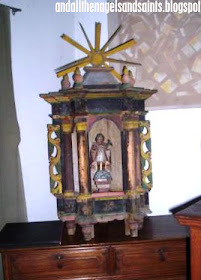Wednesday, June 13, 2012
112. BEFORE STRANGE ALTARS
When devotional santos found their way into Philippine homes, they had their own special places atop mesa altars--altar tables--which became a standard piece of furniture in the homes of Filipino Catholic families. Further reverence was accorded these santos by putting them inside home altars--locally called urnas--not only to protect them, but also to mimic the church altars with beautifully designed retablos and nichos to house these religious figures.
Folk artisans crafted wooden altars such as these examples from different periods and imbued with distinctive styles. The first two examples above are from the Visayan region, similarly made with a sunburst topper, columns, legs and signature flanges (palikpik) with cut-out decorations. The urnas are crudely carved but brightly painted in contrasting colors. Such primitive altars were made from remnant wood pieces, including wood crate packaging that are sometimes imprinted with the brand name of the product.
Other common altar designs are these urnas with leafy, sinuous floral frontals, carved in low relief. The characteristic rounded opening, and the simple rectangular base are consistent features of these urna types.
The niches are outfitted with glass-panelled doors, but a lot of these urna types are available in the market sans their doors.
The province of Bohol is known for its very distinctive 19th c. urnas that are easily recognizable by their vivid polychromed colors and their simple structure, with parts put together by pegs and joints. Each piece is carved in low relief, with floral and vegetal motifs concentrated on the two side panels anchored with columns, the topperboard and the base.
The removable base is multi-tiered, usually showing 3 gradas (levels). Detached bases with missing altars are often sold separately and are used by collectors for other decorative purposes.
I have seen a lot of these boxy urnas in northern Luzon, and they are a common sight in Manila antique shops. The above example is almost complete, except for a missing glass-panelled door. Note the serpentine-like decorative panels on both sides of the altar and the four columns that support the structure. The figures of Jose, Maria and Jesus are directly pegged onto the floor of the urna. The altar legs end in stylized 'clawfoot' forms.
An incomplete example of the same style is shown above, featuring a Madonna and Child. The decorative side panels and the door are missing, as these pieces were often just joined to the altar body using pegs and short nails and are thus, easily damaged or lost.
The urna of San Vicente Ferrer is also of the same type as the previous two. Note the serrated edges of the door, which has lost its glass panel, a common treatment artisans used in fashioning these folk altars. The roof is also missing--which may have been made of wood or tin.
From Bohol comes this more sophisticated urna, elaborated with oversized finials, the 'eye of God" topper, carved side trims and turned Greek-inspired columns. There are floral appliques on the top and base of the altar structure. The floor of the urna is trapezoidal in shape, giving it a more expansive look.
This next example is a finely crafted urna done in the neoclassic style and executed in heavy dark wood. The roof is glass-panelled, like the body. Lean Corinthian columns hold up the roof, supported by carved, gold-leafed brackets on the base. This must have housed an exquisite ivory santo.
From the 30s down to the 60s, commercial religious statuary shops offered these box-type wooden altars that were simply varnished and carved with decorative details such as Christ's or the Virgin's monograms, gothic design motifs, crosses. These streamlined, glass-panelled urnas were mass-produced, so one sometimes find the same design executed in different-sized versions.
Carved along gothic lines, such urnas feature pointed arches topped by crosses and trefoil forms. Many of these sturdy examples have survived today and chances are, you'll find one or two in the current stocks of downtown Manila antique shops. Whether primitively-carved or commercially-crafted, these home altars represent not only the reverence of the people who bought them for their treasured santos, but also the skill, artistry and creativity of the Filipino artisans who lovingly made them.














If it's ok, I hope you don't mind if I quoted you on my site? ty
ReplyDeleteit's okay, no prob.
ReplyDelete